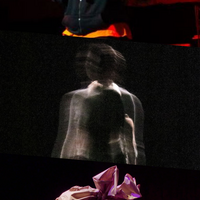Thu 12 May: Anna Alvarez/Kashish Gaba/ Dance.Film.Performance

News Story
Anna Alvarez Where Are My Glasses?
Kashish Gaba Abide Me
Dance.Film.Performance ‘Three Sisters. Between the Lines’
Sandwiched between slices of theatrical dance, Kashish Gaba’s Abide Me forms a filling of double-takes and discombobulation. Kim Chi Le and Shradha Roy Gupta don’t so much act as act out Gaba’s wrong-footing choreography that begins with the pair step-stamping in unison, like rudimentary robots (in lifejackets, as it happens), accumulates mechanical flips and falls, zig-zags down a path delineated by fluorescent fencing, breaks off for some bopping, and ends with a watched kettle, boiling. All this punctuated by bug-eyed swoons, strangled attempts to vocalise words (they eventually coalesce into “Would you like some tea?”), and smirks between the two women, as if the joke were between them as well as on us. If the what and the why of the piece are befuddling, the how is always clear, I appreciate that.
Anna Alvarez’s opening Where Are My Glasses? is a more conventionally legible portrait. At first she’s a stylish presence, trench-coated and trilby-hatted in a bobbed wig, part tango dancer, part Fosse showgirl. It’s all appearance though: her suitcase holds a stack of porcelain plates that – divested of her disguise – she strews as stepping stones which crack and splinter as she teeters across them. The plates may be all over the place but in the end she pulls herself together, arms stretching like wings. This reclamation of self may be a simple story, but Alvarez’s gravitas and physical assurance give it depth.
Depth is tantalisingly out of reach in the closing work, Angelina Gorgaeva’s Three Sisters. Inspired by Chekhov’s play, the work’s subtitle, Between the Lines, gives a clue to its treatment: as well as the sisters, two masked, shadow-black figures haunt the piece like ghosts from the past or demons from within – unspoken forces from “between the lines” of the drama. It’s an intriguing and initially captivating conceit, piquing imagination as well as curiosity. Yet the dancing feels very verbose, busily illustrating its source and in thrall to the dancers’ technical skills: stretches, pitches, high kicks, swift tumbles, all laced with gestures and glances. Allowing more space between the lines of the choreography might allow more of its own inner meanings to emerge.
Sanjoy Roy
Where Are My Glasses?, an emotive solo using a mundane domestic item: a dinner plate to plot a journey from a first incidence of domestic violence through a descent into regular and repeated abuse, framed by a macabre tango and an unconvincing disguise. An isolated Anna Alvarez repeatedly breaks plates and then rolls on a stage awash with shattered porcelain. Her final act is a curtsy- in defiance or defeat, it is not clear. The dangerous nature of this performance creates a palpable sense of unease.
Kim Chi Le and Shradha Roy Gupta begin a strange, silent march in Kashish Gaba’s Abide Me on a stage cordoned off by orange plastic fencing, wearing lifejackets that constrain their stilted, mathematical movement. There is something not quite human about the duet, punctuated with cartoonish expressions. The comedic timing is superb, and they jump into a jazzy dance break, exchanging knowing smiles. The piece climaxes as the audience are asked if they would like a cup of tea. One person’s request for coffee was met with utter disgust; a true highlight. Completely peculiar and completely hilarious.
Five dancers set the stage for Angelina Gorgaeva’s Three Sisters: two ominous, masked: figures and three sisters. A narration begins and a dining table is set; however, the narrative quickly unravels in a confusing series of set adjustments. Each of the sisters is described by the narrator as different, both in character and age, however this did not translate clearly into their movement. They each encounter the masked figures, but the effect of these meetings is not clear. The sisters dance jovially, displaying impressive technique and precision. The piece ends as it began, with the sisters at the dining table and the shadow-like people sat at their own, separate, table.
Olivia Foskett


